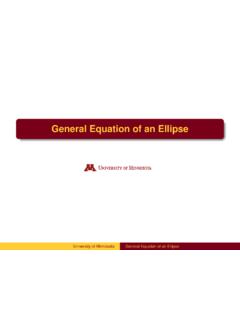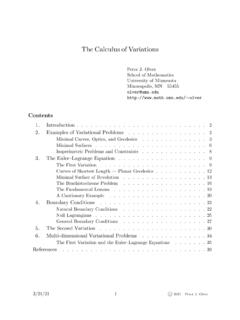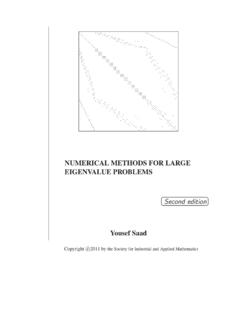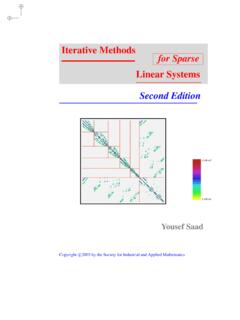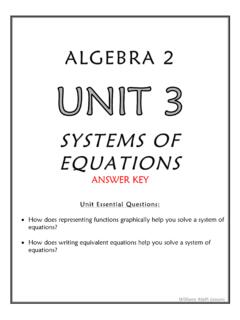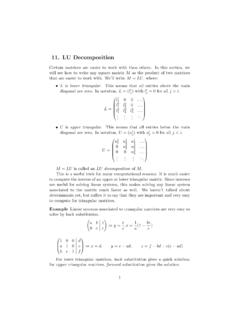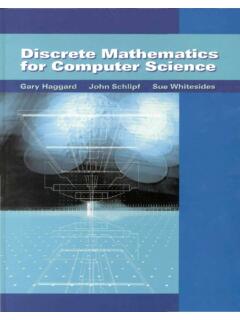Transcription of Types of Functions Algebraic Functions
1 MATH 1170 Chapter 1 Worksheet #1 NAMENote:It Ibolded and underlineda term, you are responsible for a verbadom definition of that term(as well as understanding that definition). If I justboldeda term, I only expect that you are comfortablewith the use of and using that term ( understanding it). Types of FunctionsNow that we have discussed what Functions are and some of their characteristics, we will explore differenttypes of fumctions. Section of the text outlines a variety of Types of Functions . Notice that since thefollowing are all Functions , they will all pass the Vertical Line FunctionsA function is called analgebraic functionif it can be constructed using Algebraic operations (such asaddition, subtraction, multiplication, division and taking roots).Polynomials, power Functions , and rational function are all Algebraic PolynomialsA functionpis apolynomialifp(x) =anxn+an 1xn 1+.
2 +a2x2+a1x+a0wherenis a nonnegative integer anda0,a1,a2,..,an 1,anare all constants calledcoefficientsof the leading coefficientan6= 0 then thedegreeofp(x) isn. A polynomial of degree 1 is called alinear function. A polynomial of degree 2 is called aquadratic function. A polynomial of degree 3 is called acubic function. A polynomial of degree 4 is called aquartic function. A polynomial of degree 5 is called aquintic function..and so often talk about findingrootsof a polynomial. This means we are finding where the graph of thefunction hits thex-axis. Finding the roots of a polynomial entails setting the polynomial equal to zero andsolving the roots ofp(x) =x2 x FunctionsThe most famous polynomial is the linear said to be alinear functionofxif the graph of the function is a line so that we can use theslope-intercept formof the equation of a line to write a formula for the function asy=mx+bwheremis the slope andbis this is the case, what domandbequal in thep(x) equation?
3 Graph the family of equationsf(x) =x+bwhere be is an integerb= 2, 1,0,1,2 on the same the family of equationsf(x) =mxwhere be is an integerm= 2, 1,0,1,2 on the same the equation for a line that passes through (2, 1) and (3,5).2 Power FunctionsA function of the formf(x) =xawhereais a constant is called apower function. The power functiontakes a variety of forms based on the type of constant different forms arrise when isna positive integer, 1/nwherenis a positive integer, and will explore these forms in the following Ifa=nwherenis a positive that isnis a positive integer then the power function is really just a type your graphing calculator, sketch a graph of the following (x) = (x) = (x) = (x) = (x) = (x) =x6 Whennisodd, what is the domain off(x) =xn? what is the range off(x) =xn? where isf(x) =xnincreasing? where isf(x) =xndecreasing? How do you know that these characteristics will hold foreveryoddn?
4 Whenniseven, what is the domain off(x) =xn? what is the range off(x) =xn? where isf(x) =xnincreasing? where isf(x) =xndecreasing? How do you know that these characteristics will hold foreveryevenn? Ifa= 1/nwherenis a positive Functions of the formf(x) =x1/nare calledroot is important to note thatroot Functions are the inverses of polynomial Functions . But what does thismean?Recall the definition of an inverse function from one of our previous lectures. (It can also be found on page62 of the Stewart text.)What does it mean to say that root Functions are the inverses of polynomial Functions ?Demonstrate thatg(x) =x1/2is the inverse function off(x) = (x) =x1/nin a different (x) =x1/n, wherenis a positive integer, a polynomial?Using your graphing calculator as a tool, sketch a graph of the following (x) =x1 (x) =x1 (x) =x1 (x) =x1/5 Whennisodd, what is the domain off(x) =x1/n? what is the range off(x) =x1/n?
5 Where isf(x) =x1/nincreasing? where isf(x) =x1/ndecreasing? How do you know that these characteristics will hold foreveryoddn?4 Whenniseven, what is the domain off(x) =x1/n? what is the range off(x) =x1/n? where isf(x) =x1/nincreasing? where isf(x) =x1/ndecreasing? How do you know that these characteristics will hold foreveryevenn? Ifa= this case,f(x) =x 1is thereciprocal (x) =x 1a polynomial?Using your graphing calculator as a tool, sketch a graph off(x) =x 1and describe the domain, rangeand intervals of increasing and decreasing:Domain:Range:Increasing:Decre asing:3 Rational FunctionsMoving on from power Functions , we will now explore our last type of Algebraic function: the functionis a ratio of two polynomials,p(x) andq(x):f(x) =p(x)q(x)Which of the previously mentioned Functions is a rational function? What happens when you evaluate thisfunction atx= 0?5 Considerf(x) =x 1x2 4.
6 Identifyp(x) andq(x). Using your graphing calculator, sketch a graph off(x). What happens atx= 2 andx= 2? Why?Exponential FunctionsTheexponential functionsare the Functions of the formf(x) =ax, where the baseais a that these function are called exponential Functions because the variable,x, is in the your graphing calculator as a tool, sketch a graph of the following Functions and describe the domain,range and intervals of increasing and (x) = (x) = (1/2) (x) = (x) = (1/3)xWhena >1, what is the domain off(x) =ax? what is the range off(x) =ax? where isf(x) =axincreasing? where isf(x) =axdecreasing? How do you know that these characteristics will hold foreverya >1?6 When 0< a <1, what is the domain off(x) =ax? what is the range off(x) =ax? where isf(x) =axincreasing? where isf(x) =axdecreasing? How do you know that these characteristics will hold forevery0< a <1?What is the difference between the functionf(x) =x2andg(x) = 2x?
7 Find the exponential functionf(x) =axwhose graph goes through the point ( 4,1/16).Logarithmic FunctionsThelogarithmic Functions ,f(x) = logax, where the baseais a positive constant, are the Functions thatare the inverse of the exponential is important to realize thatlogarithmic Functions are the inverses of exponential does it mean to say thatf(x) = logaxis the inverse ofg(x) =ax?Show thatf(x) = log2xis the inverse ofg(x) = 2x. (Hint:This may require you to use the laws oflogarithms that can be found on page 65 on Stewart.)7 Using your graphing calculator as a tool, sketch a graph of the following Functions and describe the domain,range and intervals of increasing and (x) = (x) = log10xDomain:Domain:Range:Range:Increasi ng:Increasing:Decreasing:Decreasing:Trig onometric FunctionsUsing your graphing calculator as a tool, sketch a graph of the following Functions and describe the domain,range and intervals of increasing and (x) = (x) = (x) = tanxDomain:Domain:Domain:Range:Range:Ran ge:Increasing:Increasing:Increasing:Decr easing:Decreasing:DecreasingWhat do you notice about the graph of: f(x) = sin(x+ /2)?
8 F(x) = sin(x+ 2 )?8 Piecewise FunctionsPiecewise Functions are defined to be one of the above Types of Functions on one part of thex-axis andanother function on a different part of example considerf(x) ={x+ 1,ifx 1x2,ifx >1 This function has the same outputs asg(x) =x+ 1 forxvalues less than of equal to 1 (the left half of thegraph) and looks likeh(x) =x2forxgreater than 1 (the right half of the graph).Sketch a graph off(x).Findf( 2).Findxwhenf(x) = that theabsolute value functionis a type of piecewise defined other words,g(x) =|x|={ x,ifx <0x,ifx 0 Sketch the graph ofg(x) =|x|and describe where it is increasing and decreasing and its domain and :Range:Increasing:Decreasing:Sketch the graphs of the following function and describe where it is increasing and decreasing and itsdomain and (x) =| 2x+ 4|f(x) = ,ifx < 2x3,if 2 x 2cosx,ifx >2 Range:Range:Domain:Domain:Increasing:Inc reasing:Decreasing:Decreasing:If you have not done so already, take this time to fill out the Types of Function}}
